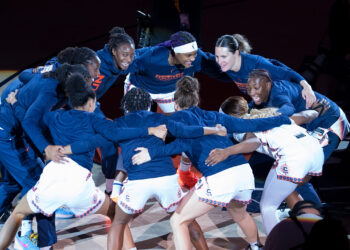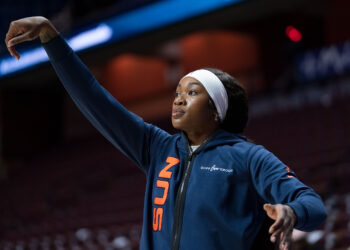The bar is different for every rookie, but most players in their first WNBA season should be satisfied if they can produce at least one “I’ve arrived” moment. A flash where, however brief, fans, teammates, and even opponents don’t just notice but admire the impact of a player still finding their footing in the league. For Connecticut Sun rookie Leïla Lacan, though, it hasn’t been about isolated flashes. A 19-point performance against the Indiana Fever at a sold-out TD Garden may be the clearest example, but the truth is her “moments” have already proven to be anything but fleeting.
Take a five-and-a-half-minute stretch against the Mercury in Phoenix on August 5 as an example of how her presence disrupts not just her individual matchup, but an entire opponent. In a late third-quarter span, she piled up six points, four steals, and two assists, fueling a 16–4 Sun run that slashed into what had been a 28-point deficit. And her influence wasn’t limited to that single surge. Against a Phoenix team that’s very much jockeying for a top-four seed, Lacan left her mark on every bit of the 22 minutes and 20 seconds she spent on the floor at PHX Arena. Even as Connecticut ultimately fell by 16, she finished with a contextually staggering +3 plus-minus, while the next-best starter, Marina Mabrey, closed at -11.
But while her impact is loud, Leïla Lacan carries herself like a respectful—if even reserved—star in the making. In multi-player postgame media sessions, she’s quick to quietly thank teammates for their compliments, while often deflecting credit for her ability to tilt games in Connecticut’s favor, insisting it’s simply “what they ask me to do.” In short, the first-year guard is wise beyond her years—somewhat unsurprisingly, given the three seasons of professional experience she logged in the French league before ever stepping onto a WNBA floor.
And yet, no amount of prior experience makes what Leïla Lacan is doing this season normal, or even easily replicable for other international prospects. Despite making her WNBA debut on July 6, after her Sun teammates had already played nearly half (17) of the season’s 44 games, Lacan isn’t just third among all rookies in steals–her 54 total takeaways place her in the top 10 across the entire league. On a per-game basis, her 2.3 steals rank her level with Defensive Player of the Year candidate and 2024 Olympic teammate Gabby Williams at the top of the league leaderboard. Adjust for minutes played, and the picture is clear: no one in the WNBA generates steals better than Lacan, with more three-plus-steal games (9) on her rookie resume than games without one (5).
Yet, the art of Lacan’s takeaways isn’t just in her instincts or her ability to jump passing lanes (as shown in the first two clips below); it’s rooted in her overall aggressive approach to defending. Sun head coach Rachid Meziane—no doubt a longtime admirer of his rookie’s game from his years as a coach in France’s top division—has repeatedly used that very word when describing her style of play, telling the media after her debut against Las Vegas that he liked her “very aggressive” energy and that it was “how she has to play” in the WNBA.
The third and fourth clips above illustrate Lacan’s aggressive approach to defending in two very different contexts. First, she willingly bodies up to the much bigger Aliyah Boston at the elbow after rotating following a blitz on Caitlin Clark at the point of attack. Lacan recognizes that once Boston puts the ball on the floor and begins to back her down, favorable outcomes for the Sun are limited. By immediately invading Boston’s space, Lacan forces a response, and the Fever big’s choice—picking up her dribble—turns out to be a fatal one.
Against Golden State in the fourth clip, we see a different side of Lacan’s aggression. This time, most of the cards are in her favor. With Veronica Burton already pinned against the sideline and Lacan tightly on her, the Valkyries guard needs a safety valve to release the ball. Rather than allowing Iliana Rupert to provide that option, Lacan blocks every angle, leaving Burton no choice but to make an ill-advised pass that Lacan ultimately deflects. The play exemplifies the relentlessness of Lacan’s efforts, which ultimately set up moments like the final clip, where—while covering Sabrina Ionescu—she forces Jonquel Jones into a basic error on a dribble-hand-off, simply by sticking with Ionescu’s lateral movements.
That ability to stick with play laterally is a key facet of Lacan’s success as an isolation defender–one that extends far beyond her knack for steals, which don’t always capture a player’s true defensive impact. After the Sun’s win against Ionescu and Jones’ Liberty on August 1, Meziane said Lacan was “everywhere” and had “stabilized” the Sun defense after arriving in the States post-EuroBasket, thanks to her ability to “contain” in one-on-one coverage. As with her takeaways, the tape backs up the coach’s praise of his compatriot in this department as well.
One of Lacan’s standout skills as a one-on-one defender is her ability to change directions multiple times without losing a step. This, again, ties back to her aggressiveness: she stays so tight on her matchup that the ball-handler must alter course, or risk an easy strip, like Lacan pulls off in the second play against Leonie Fiebich. Because of her tight coverage, these changes of direction usually come at a slower speed than they would if the ball-handler had room for an explosive first step. Even driving across the court rather than downhill to protect the ball and let the play develop isn’t effective, as Chelsea Gray discovered in the third clip, because Lacan’s wingspan is more than enough to close the small gap her positioning leaves to the basketball.
In fairness, all of this tight coverage isn’t without risks–Leïla Lacan ranks second in the league in fouls committed since her debut on July 6 and averages more fouls per game (3.3) than any player on Connecticut’s roster. For context, Saniya Rivers—a similarly aggressive defender who logs nearly identical minutes for the Sun—has committed fewer total fouls this season despite playing 15 more games. Still, given that Meziane has said this is how Lacan “has to play,” it’s safe to assume the coach will accept the pitfalls of her aggressive style and likely expects those numbers to ease as she becomes more familiar with the boundaries officials are willing to tolerate.
While understanding the WNBA whistle is still a work in progress, Leïla Lacan has proven a surprisingly quick study on the other end of the floor, with her offensive impact exceeding what even her most bullish advocates might have expected before she arrived in Connecticut. Her scoring numbers (10.2 points per game on 47.8 percent shooting) are solid, especially for a non-shooter (23.1 percent from three), but it’s her ability to create off the dribble and attack the rim that has been most influential in improving Connecticut’s offense. Though the Sun remain at the bottom of the league in offensive rating, they have quickly closed the gap with the rest of the W since Lacan’s arrival.
The impact of those drives has certainly not gone unnoticed by Lacan’s teammates. Mabrey told the media after the aforementioned victory against the reigning champion Liberty that Lacan’s offensive style made things “really hard for other defenses, especially when they want to play drop coverage.” The veteran guard, no slouch as a playmaker herself (team-best 3.9 assists per game), also praised Lacan’s “willingness” to share the basketball and her ability to “always see that extra pass.”
Looking at the tape, it’s not hard to see why Mabrey and others have become such big fans of Lacan’s style. In modern basketball, the two shots coaches (at least analytically minded ones) covet most are from the restricted area and from behind the arc, and the style of drives Lacan repeatedly executes in are the necessary bridge between those two areas. The collapsing effect of someone like Lacan (72.0 percent shooting at the rim) driving to the basket is considerable, and the unselfish nature that Mabrey described makes her a multi-dimensional threat that teams will understandably struggle to contain off the bounce.
Beyond the straight-line drives, the clips above also highlight how clever Leïla Lacan is with her angles of attack. She regularly drives on a diagonal—or even slaloming—path toward the basket, which draws extra defenders and frees a teammate for an open three. The final two clips illustrate this perfectly: in both cases, Lacan deliberately narrows her own angle by driving horizontally across the paint just outside the restricted area. In doing so, she draws attention from Sarah Ashlee Barker (clip five) and Erica Wheeler (clip six), in addition to the two defenders already on her and the big stationed on the block. At that point, it doesn’t take a math major to see that someone is open, and Lacan only needs a simple offload to generate a clean look from three.
This may seem like a rather academic decision, but Lacan could easily have driven more directly at the basket and failed to engage the extra help in both cases. For all her skill as a passer, it’s her ability to create these advantageous scenarios with her movement before the pass is thrown that has been most striking in her abbreviated rookie campaign. Meziane has spoken to that specific impact, saying that Lacan’s drives “activate help” and that his team could find open shots “through her aggressiveness.” At a broader level, he highlighted her effect on the offense’s second-half growth, saying, “It’s very cool to have players who can do something different.”
Indeed, much of what Leïla Lacan has done as a rookie has been just that—different. From arriving midway through the season and finding her way into the rotation (and eventually the starting five) to producing multiple statistically noteworthy, eye-catching performances, the twenty-one-year-old from the Occitanie region of southern France seems a literal embodiment of the tired cliché of a rookie with “unlimited potential.” The Sun’s most distinguished veteran, Tina Charles, offered a similar sentiment, saying Lacan “adjusted tremendously, like no other player that I’ve seen come to a team midseason.” The future Hall of Famer went so far as to say that rookies of Lacan’s pro-readiness were “the evolution of our game.”
The natural question for Lacan, then, becomes: what will her evolution look like? While much of the WNBA braces for a significant roster overhaul this winter, Connecticut—despite plenty of noise about the franchise’s off-court future—has the luxury of returning five of its top eight rotational pieces next season, assuming the team exercises its restricted free-agent rights on center Olivia Nelson-Ododa. That stable foundation, which seems likely to include Meziane continuing in his role after a solid second half (7-12 record since the All-Star break), will no doubt help Lacan continue to spread her wings.
Meanwhile, another “offseason” playing in the EuroLeague—Leïla Lacan is expected to return to last season’s losing quarterfinalists, Landes, in France this winter. This should allow her to continue to sharpen her game against many of the best players in the world. Thus, the question for Lacan probably shouldn’t be if she will improve, but by how much. Given her current standard, an All-Defense team selection is not out of the question in 2026, and the Sun’s relocation to a bigger market could accelerate her rise into stardom even faster than her on-court game already is. As Meziane put it quite simply (and with a laugh) on Lacan’s future after her debut: “to be continued…”
All stats as of September 5th. Unless otherwise noted, all stats courtesy of Basketball Reference and WNBA.com.

















